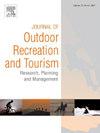Urban forest visitors’ perceptions of biodiversity and its effects on their well-being
IF 3.6
3区 管理学
Q1 HOSPITALITY, LEISURE, SPORT & TOURISM
Journal of Outdoor Recreation and Tourism-Research Planning and Management
Pub Date : 2025-04-08
DOI:10.1016/j.jort.2025.100886
引用次数: 0
Abstract
The rapid loss of biological diversity due to human activities has increased interest in understanding the interdependencies between humans and biodiversity. The evidence base for the health and well-being effects of nature-based recreation is strong, but less is known about the role of biodiversity. This qualitative study explores the complex relationship between perceived biodiversity and well-being through the following questions: 1) how do visitors of an urban forest perceive different aspects of biodiversity, and 2) how do the different aspects of biodiversity affect their perceived well-being? These biodiversity aspects applied are species encountering, diversity and abundance, interactions between species, natural processes, sounds, colors, shapes, textures, smells, and seasonal changes. The data consists of semi-structured interviews of participants (n = 12) on two guided visits in the Lahti Health Forest, Finland.
The participants paid effortlessly attention to sounds, colors, and strong natural smells, whereas processes, textures, and shapes required more focus. Perceptions were affected by intentionality, activity, mindset, ecological knowledge, quality, and familiarity with a forest. The findings indicate that the multisensory experience of biodiversity is significant for the restorative and stress reduction potential of a recreational forest. At the same time, processes, seasonal changes, and textures are meaningful regarding spiritual well-being. The findings emphasize the potential of biodiverse nature to improve well-being comprehensively. By paying attention to the perceivable attributes of biodiversity in urban areas and promoting the recreational use of biodiverse natural environments, mutual benefits could be achieved for both biodiversity protection and human well-being.
城市森林游客对生物多样性的认知及其对幸福感的影响
由于人类活动导致生物多样性的迅速丧失,人们对了解人类与生物多样性之间的相互依赖关系越来越感兴趣。以自然为基础的娱乐活动对健康和福祉的影响有很强的证据基础,但对生物多样性的作用知之甚少。本定性研究通过以下问题探讨了感知生物多样性与幸福感之间的复杂关系:1)城市森林游客如何感知生物多样性的不同方面,2)生物多样性的不同方面如何影响他们的感知幸福感。这些应用的生物多样性方面包括物种相遇、多样性和丰度、物种之间的相互作用、自然过程、声音、颜色、形状、质地、气味和季节变化。数据包括对参与者(n = 12)在芬兰拉赫蒂健康森林的两次指导访问中的半结构化访谈。参与者毫不费力地将注意力集中在声音、颜色和强烈的自然气味上,而过程、纹理和形状则需要更多的注意力。感知受意向性、活动、心态、生态知识、质量和对森林的熟悉程度的影响。研究结果表明,生物多样性的多感官体验对休闲森林的恢复和减压潜力具有重要意义。与此同时,过程、季节变化和纹理对于精神健康是有意义的。研究结果强调了生物多样性在全面改善人类福祉方面的潜力。通过关注城市地区生物多样性的可感知属性,促进生物多样性自然环境的娱乐利用,可以实现生物多样性保护和人类福祉的双赢。
本文章由计算机程序翻译,如有差异,请以英文原文为准。
求助全文
约1分钟内获得全文
求助全文
来源期刊

Journal of Outdoor Recreation and Tourism-Research Planning and Management
HOSPITALITY, LEISURE, SPORT & TOURISM-
CiteScore
6.70
自引率
5.30%
发文量
84
期刊介绍:
Journal of Outdoor Recreation and Tourism offers a dedicated outlet for research relevant to social sciences and natural resources. The journal publishes peer reviewed original research on all aspects of outdoor recreation planning and management, covering the entire spectrum of settings from wilderness to urban outdoor recreation opportunities. It also focuses on new products and findings in nature based tourism and park management. JORT is an interdisciplinary and transdisciplinary journal, articles may focus on any aspect of theory, method, or concept of outdoor recreation research, planning or management, and interdisciplinary work is especially welcome, and may be of a theoretical and/or a case study nature. Depending on the topic of investigation, articles may be positioned within one academic discipline, or draw from several disciplines in an integrative manner, with overarching relevance to social sciences and natural resources. JORT is international in scope and attracts scholars from all reaches of the world to facilitate the exchange of ideas. As such, the journal enhances understanding of scientific knowledge, empirical results, and practitioners'' needs. Therefore in JORT each article is accompanied by an executive summary, written by the editors or authors, highlighting the planning and management relevant aspects of the article.
 求助内容:
求助内容: 应助结果提醒方式:
应助结果提醒方式:


